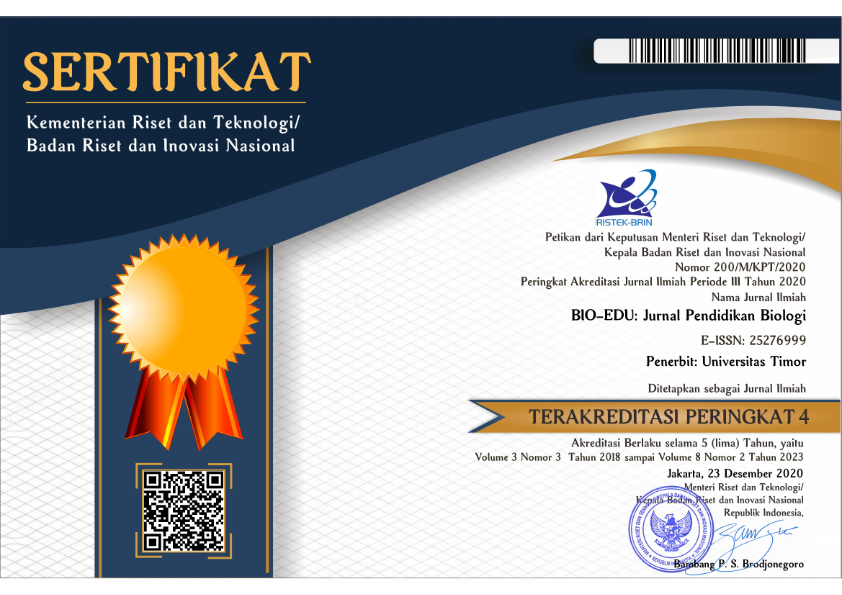Analisis Perbedaan Kemampuan Interpretasi Data Numerasi Mahasiswa Pendidikan Biologi di Kalimantan Selatan Berdasarkan Masa Studi yang Telah Ditempuh
DOI:
https://doi.org/10.32938/jbe.v8i2.3911Keywords:
Comparative analysis; numeration data interpretation ability; numeracy data analysis ability; biology education students; study period has been takenAbstract
Numeracy literacy is important for biology education students as pre-service teachers. Numeracy literacy ability can support students in conducting analyses related to quantitative data. Meanwhile, for biology teachers, numeracy literacy ability can support the process of analysis and evaluation of learning that is closely related to quantitative data. One indicator of numeracy literacy is the ability to interpret numerical data, which can support 21st-century learning competencies. This study aims to analyze differences in the ability to interpret numerical data for biology education students in South Kalimantan based on the study period that has been taken. This type of research is quantitative comparative research. The sample subjects for this study were 245 students of the Biology Education study program in South Kalimantan. The instrument for measuring the ability to interpret numeracy data was collected using a test instrument referring to AACU (2009). Data were analyzed using the ANOVA test and continued with Duncan's test to analyze differences between groups of students based on the study period that has been taken. The results showed significant differences in the ability to interpret numerical data for biology education students based on the study period that has been taken.
References
Association of American Colleges and Universities. (2009). Value rubrics. Multi-State Collaborative to Advance Learning Outcomes Assessment, 1–32. http://www.aacu.org/value
Batzel, J. J., Hinghofer-Szalkay, H., Kappel, F., Schneditz, D., Kenner, T., & Goswami, N. (2012). Bridging different perspectives of the physiological and mathematical disciplines. American Journal of Physiology - Advances in Physiology Education, 36(4), 265–274. https://doi.org/10.1152/advan.00074.2012
Baumgartner, E., Biga, L., Bledsoe, K., Dawson, J., Grammer, J., Howard, A., & Snyder, J. (2015). Exploring phytoplankton population investigation growth to enhance quantitative literacy. American Biology Teacher, 77(4), 265–272. https://doi.org/10.1525/abt.2015.77.4.6
Chen, M. M., Scott, S. M., & Stevens, J. D. (2018). Technology as a tool in teaching quantitative biology at the secondary and undergraduate levels: a review. Letters in Biomathematics, 5(1), 30–48. https://doi.org/10.1080/23737867.2017.1413432
Crowther, G. J., Davis, K., Jenkins, L. D., & Breckler, J. L. (2015). Integration of Math Jingles into Physiology Courses. Journal of Mathematics Education, 8(2), 56–73.
Dauer, J., Mayes, R., Rittschof, K., & Gallant, B. (2021). Assessing quantitative modelling practices, metamodelling, and capability confidence of biology undergraduate students. International Journal of Science Education, 43(10), 1685–1707. https://doi.org/10.1080/09500693.2021.1928325
Harianto, Y., Saefudin, S., & Nuraeni, E. (2017). Analysis of students’ quantitative literacy in human coordination system concept. International Journal of Science and Applied Science: Conference Series, 2(1), 440. https://doi.org/10.20961/ijsascs.v2i1.16764
Knowles, A., Linsell, C., Baeumer, B., & Anakin, M. (2021). The development and efficacy of an undergraduate numeracy assessment tool. The Annual Meeting of the Mathematics Education Research Group of Australasia (MERGA) (43rd, Singapore), 243–250. https://eric.ed.gov/?id=ED616235
Lauermann, J. (2021). Building quantitative literacy in critical human geography curriculum. Journal of Geography in Higher Education, 1–9. https://doi.org/10.1080/03098265.2021.1957799
Lee-Post, A. (2019). Developing numeracy and problem-solving skills by overcoming learning bottlenecks. Journal of Applied Research in Higher Education, 11(3), 398–414. https://doi.org/10.1108/JARHE-03-2018-0049
Llamas, A., Vila, F., & Sanz, A. (2012). Mathematical skills in undergraduate students. A ten-year survey of a Plant Physiology course. Bioscience Education, 19, 1–10. https://doi.org/10.11120/beej.2012.19000006
Nel, B. P. (2020). Implications of the quantitative literacies test results of the national benchmark test project (NBTP) for teachers. South African Journal of Education, 40(1), 1–8. https://doi.org/10.15700/saje.v40n1a1792
Nuraeni, E., Soesilawaty, S., Permana, I., & Rahmania, S. (2020). Students’ Biological-Mathematical Attitude in Quantitative Literacy-Based Learning on the Topic of Ecosystem. Proceedings of the 7th Mathematics, Science, and Computer Science Education International Seminar, MSCEIS 2019. https://doi.org/10.4108/eai.12-10-2019.2296319
Pendidikan Biologi ULM. (2020). Kurikulum MBKM Pendidikan Biologi ULM Tahun 2020.
Rafianti, I., Setiani, Y., & Novaliyosi, N. (2018). Profil Kemampuan Literasi Kuantitatif Calon Guru Matematika. Jurnal Penelitian Dan Pembelajaran Matematika, 11(1), 63–74. https://doi.org/10.30870/jppm.v11i1.2985
Rahmawati, D., Rusilowati, A., & Hardyanto, W. (2021). The Effect of Practicum Activities on Improving Data Literacy for High School Students. Physics Communication, 5(1), 12–17. https://doi.org/10.15294/physcomm.v5i1.34635
Roohr, K. C., Graf, E. A., & Liu, O. L. (2014). Assessing Quantitative Literacy in Higher Education: An Overview of Existing Research and Assessments With Recommendations for Next-Generation Assessment. In ETS Research Report Series. Princeton, NJ; Educational Testing Service. https://doi.org/10.1002/ets2.12024
Speth, E. B., Momsen, J. L., Moyerbrailean, G. A., Ebert-may, D., Long, T. M., Wyse, S., & Linton, D. (2010). 1 , 2 , 3 , 4 : Infusing Quantitative Literacy into Introductory Biology. Life Science Education, 9, 323–332. https://doi.org/10.1187/cbe.10
Stanhope, L., Ziegler, L., Haque, T., Le, L., Vinces, M., Davis, G. K., Zieffler, A., Brodfuehrer, P., Preest, M., Belitsky, J. M., Umbanhowar, C., & Overvoorde, P. J. (2017). Development of a biological science quantitative reasoning exam (Biosquare). CBE Life Sciences Education, 16(4), 1–10. https://doi.org/10.1187/cbe.16-10-0301
Wills, J. B., & Atkinson, M. P. (2007). Table Reading Skills as Quantitative Literacy. Teaching Sociology, 35(3), 255–263. http://www.jstor.org/stable/20058574
Downloads
Published
Issue
Section
License
The Authors submitting a manuscript do so on the understanding that if accepted for publication, the copyright of the article shall be assigned to BIO-EDU: Jurnal Pendidikan Biologi and Departement of Biology Education, Universitas Timor as the publisher of the journal. Copyright encompasses rights to reproduce and deliver the article in all form and media, including reprints, photographs, microfilms, and any other similar reproductions, as well as translations.
BIO-EDU journal and Departement Biology Education, Universitas Timor, and the Editors make every effort to ensure that no wrong or misleading data, opinions, or statements be published in the journal. In any way, the contents of the articles and advertisements published in BIO-EDU are the sole and responsibility of their respective authors and advertisers.
Users of this website will be licensed to use materials from this website following the Creative Commons Attribution-ShareAlike 4.0 International License.



















